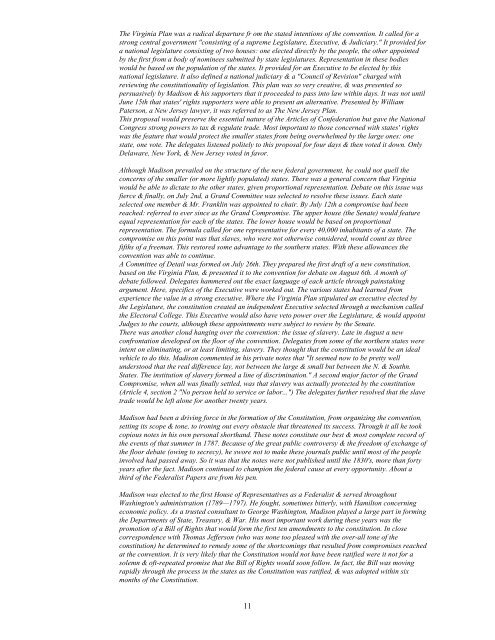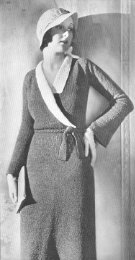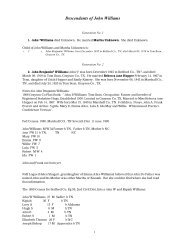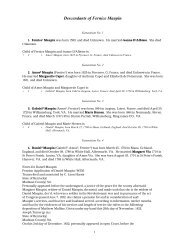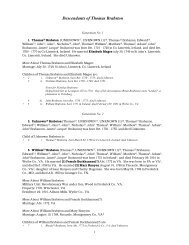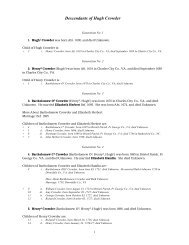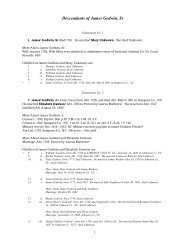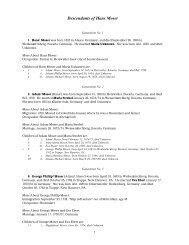Family Tree Maker - Cemetarian
Family Tree Maker - Cemetarian
Family Tree Maker - Cemetarian
- No tags were found...
You also want an ePaper? Increase the reach of your titles
YUMPU automatically turns print PDFs into web optimized ePapers that Google loves.
The Virginia Plan was a radical departure fr om the stated intentions of the convention. It called for astrong central government "consisting of a supreme Legislature, Executive, & Judiciary." It provided fora national legislature consisting of two houses: one elected directly by the people, the other appointedby the first from a body of nominees submitted by state legislatures. Representation in these bodieswould be based on the population of the states. It provided for an Executive to be elected by thisnational legislature. It also defined a national judiciary & a "Council of Revision" charged withreviewing the constitutionality of legislation. This plan was so very creative, & was presented sopersuasively by Madison & his supporters that it proceeded to pass into law within days. It was not untilJune 15th that states' rights supporters were able to present an alternative. Presented by WilliamPaterson, a New Jersey lawyer, it was referred to as The New Jersey Plan.This proposal would preserve the essential nature of the Articles of Confederation but gave the NationalCongress strong powers to tax & regulate trade. Most important to those concerned with states' rightswas the feature that would protect the smaller states from being overwhelmed by the large ones: onestate, one vote. The delegates listened politely to this proposal for four days & then voted it down. OnlyDelaware, New York, & New Jersey voted in favor.Although Madison prevailed on the structure of the new federal government, he could not quell theconcerns of the smaller (or more lightly populated) states. There was a general concern that Virginiawould be able to dictate to the other states, given proportional representation. Debate on this issue wasfierce & finally, on July 2nd, a Grand Committee was selected to resolve these issues. Each stateselected one member & Mr. Franklin was appointed to chair. By July 12th a compromise had beenreached: referred to ever since as the Grand Compromise. The upper house (the Senate) would featureequal representation for each of the states. The lower house would be based on proportionalrepresentation. The formula called for one representative for every 40,000 inhabitants of a state. Thecompromise on this point was that slaves, who were not otherwise considered, would count as threefifths of a freeman. This restored some advantage to the southern states. With these allowances theconvention was able to continue.A Committee of Detail was formed on July 26th. They prepared the first draft of a new constitution,based on the Virginia Plan, & presented it to the convention for debate on August 6th. A month ofdebate followed. Delegates hammered out the exact language of each article through painstakingargument. Here, specifics of the Executive were worked out. The various states had learned fromexperience the value in a strong executive. Where the Virginia Plan stipulated an executive elected bythe Legislature, the constitution created an independent Executive selected through a mechanism calledthe Electoral College. This Executive would also have veto power over the Legislature, & would appointJudges to the courts, although these appointments were subject to review by the Senate.There was another cloud hanging over the convention: the issue of slavery. Late in August a newconfrontation developed on the floor of the convention. Delegates from some of the northern states wereintent on eliminating, or at least limiting, slavery. They thought that the constitution would be an idealvehicle to do this. Madison commented in his private notes that "It seemed now to be pretty wellunderstood that the real difference lay, not between the large & small but between the N. & Southn.States. The institution of slavery formed a line of discrimination." A second major factor of the GrandCompromise, when all was finally settled, was that slavery was actually protected by the constitution(Article 4, section 2 "No person held to service or labor...") The delegates further resolved that the slavetrade would be left alone for another twenty years.Madison had been a driving force in the formation of the Constitution, from organizing the convention,setting its scope & tone, to ironing out every obstacle that threatened its success. Through it all he tookcopious notes in his own personal shorthand. These notes constitute our best & most complete record ofthe events of that summer in 1787. Because of the great public controversy & the freedom of exchange ofthe floor debate (owing to secrecy), he swore not to make these journals public until most of the peopleinvolved had passed away. So it was that the notes were not published until the 1830's, more than fortyyears after the fact. Madison continued to champion the federal cause at every opportunity. About athird of the Federalist Papers are from his pen.Madison was elected to the first House of Representatives as a Federalist & served throughoutWashington's administration (1789—1797). He fought, sometimes bitterly, with Hamilton concerningeconomic policy. As a trusted consultant to George Washington, Madison played a large part in formingthe Departments of State, Treasury, & War. His most important work during these years was thepromotion of a Bill of Rights that would form the first ten amendments to the constitution. In closecorrespondence with Thomas Jefferson (who was none too pleased with the over-all tone of theconstitution) he determined to remedy some of the shortcomings that resulted from compromises reachedat the convention. It is very likely that the Constitution would not have been ratified were it not for asolemn & oft-repeated promise that the Bill of Rights would soon follow. In fact, the Bill was movingrapidly through the process in the states as the Constitution was ratified, & was adopted within sixmonths of the Constitution.11


